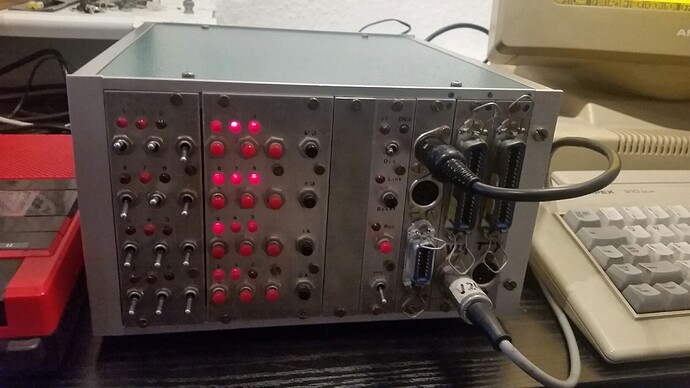8473… would result in having the empty page at page 0. I had excluded that then as I thought the start would be at 0.
Starting from 400 first seems plausible. But it overwrites everything with 3527 starting at 11. Maybe this is the RAM check? After that there are infinite loops. At 20 3527 acts then as instruction what is probably wrong. (But RAM <>ROM). Trace run below.
The LCD is the most interesting and complicated part. I’ve described it in 3 posts:
Help with c code (bit reversal) - #41 by mainframetom
Help reading EPROM (Intersil IM6654A) and analyze firmware - #64 by mainframetom
I don’t know the IOT. In the manual I have a table but I doubt that it’s stored as such. 2 characters forming one word, addition of 2 BCD values. Mainly for Ex and Fx. F0=0320. E0=360. 2 fixed values (bit patterns) for location 4 3x blank 6314 and 3x_ =7356. With that logic 4314 should be 2xblank. And 14 1x. 356 1x_
The LCD positions building 4 units/addresses AP1-AP4 0051-54 and can only be loaded. The allowed operation is stored at 762. There’s a command to delete all locations that is unit 0050. All this is only confirmed for the LCD of the PLC but it’s the same style. Loading itself is another instruction eg
…if…
then load AP4 040054 (4=load)
with decimal 8 070010 (7=with decimal, 10=octal)
I don’t know if there’s an LCD driver IC. I can’t remove that PCB without destroying it. The display can’t display text except F and E.
Text (mnemonics) stored at 6000 can only be printed out or exported. The text don’t have blanks. 00 as separator.
The baud settings are operands when exporting or importing. Eg import F 0 (r) (b) ADR, r=0 without reflection, 1 with reflection. b= 0 TTY 110 baud, 1=TTY 300 baud, 2=TTY 600 baud, 3=TTY 1200 baud, 4=Audio 110 baud… 7 Audio 1200 baud. Possible pattern found described here
PDP-8 mystery data, 8 values, LCD bit pattern?
/ and XON: A printout starting with /L 00000 - 00007 S: 0000270003. “/” is ASCII 2F what is 0057 octal. That is stored at 6542 followed by 21 what is control character XON (DC1). XOFF 23 is at 6570, CR+LF 15/12 could be at 572. The mnemonics printed after that aren’t stored as ASCII but as a unique Sixbit. You found a table here
Festo mnemonics text found in ROM code (new PDP-8 encoding)
[0400] IRQ,DLY,IE=0,1,0 L/AC:0/0000 MQ:0000 IR:6007 CAF ;KK8-E: Clear all flags
[0401] IRQ,DLY,IE=0,1,0 L/AC:0/0000 MQ:0000 IR:1354 TAD @@54 ;Add operand to AC, Current page @@54
[0402] IRQ,DLY,IE=0,1,0 L/AC:0/6100 MQ:0000 IR:6415 SRS1 ;DP8-EAEB: Read Status 1
[0403] IRQ,DLY,IE=0,1,0 L/AC:0/6100 MQ:0000 IR:1273 TAD @@73 ;Add operand to AC, Current page @@73
[0404] IRQ,DLY,IE=0,1,0 L/AC:1/0402 MQ:0000 IR:6415 SRS1 ;DP8-EAEB: Read Status 1
[0405] IRQ,DLY,IE=0,1,0 L/AC:1/0402 MQ:0000 IR:1300 TAD @@00 ;Add operand to AC, Current page @@00
[0406] IRQ,DLY,IE=0,1,0 L/AC:1/1002 MQ:0000 IR:6414 SRS2 ;DP8-EAEB: Read Status 2
[0407] IRQ,DLY,IE=0,1,0 L/AC:1/1002 MQ:0000 IR:1272 TAD @@72 ;Add operand to AC, Current page @@72
[0410] IRQ,DLY,IE=0,1,0 L/AC:1/3527 MQ:0000 IR:7421 MQL ;Load MQ from AC then clear AC
[0411] IRQ,DLY,IE=0,1,0 L/AC:1/0000 MQ:3527 IR:1270 TAD @@70 ;Add operand to AC, Current page @@70
[0412] IRQ,DLY,IE=0,1,0 L/AC:1/7411 MQ:3527 IR:3000 DCA 0000 ;Deposit AC to memory then clear AC, ZP 0000
[0413] IRQ,DLY,IE=0,1,0 L/AC:1/0000 MQ:3527 IR:1313 TAD @@13 ;Add operand to AC, Current page @@13
[0414] IRQ,DLY,IE=0,1,0 L/AC:1/0010 MQ:3527 IR:3010 DCA 0010 ;Deposit AC to memory then clear AC, ZP 0010
[0415] IRQ,DLY,IE=0,1,0 L/AC:1/0000 MQ:3527 IR:7501 MQA ;OR MQ with AC
[0416] IRQ,DLY,IE=0,1,0 L/AC:1/3527 MQ:3527 IR:3410 DCA I 0010 ;Deposit AC to memory then clear AC, Indexed ZP 0010 [Auto pre-inc]
[0417] IRQ,DLY,IE=0,1,0 L/AC:1/0000 MQ:3527 IR:2000 ISZ 0000 ;Increment operand and skip if zero, ZP 0000
[0420] IRQ,DLY,IE=0,1,0 L/AC:1/0000 MQ:3527 IR:5215 JMP @@15 ;Jump Current page @@15
[0415] IRQ,DLY,IE=0,0,0 L/AC:1/0000 MQ:3527 IR:7501 MQA ;OR MQ with AC
[0426] IRQ,DLY,IE=0,0,0 L/AC:1/3527 MQ:3527 IR:7041 CIA ;2s Complement AC
[0427] IRQ,DLY,IE=0,0,0 L/AC:1/4251 MQ:3527 IR:1410 TAD I 0010 ;Add operand to AC, Indexed ZP 0010 [Auto pre-inc]
[0430] IRQ,DLY,IE=0,0,0 L/AC:0/0000 MQ:3527 IR:7640 SZA CLA ;Skip on AC = 0, Clear AC
[0432] IRQ,DLY,IE=0,0,0 L/AC:0/0000 MQ:3527 IR:2000 ISZ 0000 ;Increment operand and skip if zero, ZP 0000
[0431] IRQ,DLY,IE=0,0,0 L/AC:1/0000 MQ:3527 IR:5335 JMP @@35 ;Jump Current page @@35
[0535] IRQ,DLY,IE=0,0,0 L/AC:1/0000 MQ:3527 IR:1271 TAD @@71 ;Add operand to AC, Current page @@71
[0536] IRQ,DLY,IE=0,0,0 L/AC:1/0371 MQ:3527 IR:6410 SSRG ;DP8-EAEB: Skip if Ring Flag
[0537] IRQ,DLY,IE=0,0,0 L/AC:1/0371 MQ:3527 IR:1010 TAD 0010 ;Add operand to AC, ZP 0010
[0540] IRQ,DLY,IE=0,0,0 L/AC:1/0407 MQ:3527 IR:6411 SSCA ;DP8-EAEB: Skip if CarrierAGC Flag
[0541] IRQ,DLY,IE=0,0,0 L/AC:1/0407 MQ:3527 IR:5341 JMP @@41 ;Jump Current page @@41
[0541] IRQ,DLY,IE=0,0,0 L/AC:1/0407 MQ:3527 IR:5341 JMP @@41 ;Jump Current page @@41
[0542] IRQ,DLY,IE=0,0,0 L/AC:1/0407 MQ:3527 IR:7001 IAC;Increment AC
[0543] IRQ,DLY,IE=0,0,0 L/AC:1/0410 MQ:3527 IR:7001 IAC;Increment AC
[0544] IRQ,DLY,IE=0,0,0 L/AC:1/0411 MQ:3527 IR:7001 IAC;Increment AC
[0545] IRQ,DLY,IE=0,0,0 L/AC:1/0412 MQ:3527 IR:7001 IAC;Increment AC
[0546] IRQ,DLY,IE=0,0,0 L/AC:1/0413 MQ:3527 IR:3142 DCA 0142 ;Deposit AC to memory then clear AC, ZP 0142
[0547] IRQ,DLY,IE=0,0,0 L/AC:1/0000 MQ:3527 IR:1036 TAD 0036 ;Add operand to AC, ZP 0036
[0550] IRQ,DLY,IE=0,0,0 L/AC:1/3527 MQ:3527 IR:3141 DCA 0141 ;Deposit AC to memory then clear AC, ZP 0141
[0551] IRQ,DLY,IE=0,0,0 L/AC:1/0000 MQ:3527 IR:3151 DCA 0151 ;Deposit AC to memory then clear AC, ZP 0151
[0552] IRQ,DLY,IE=0,0,0 L/AC:1/0000 MQ:3527 IR:3076 DCA 0076 ;Deposit AC to memory then clear AC, ZP 0076
[0553] IRQ,DLY,IE=0,0,0 L/AC:1/0000 MQ:3527 IR:4017 JMS 0017 ;Jump to subroutine ZP 0017
[0020] IRQ,DLY,IE=0,0,0 L/AC:1/0000 MQ:3527 IR:3527 DCA I 0127 ;Deposit AC to memory then clear AC, Indexed ZP 0127
[0021] IRQ,DLY,IE=0,0,0 L/AC:1/0000 MQ:3527 IR:3527 DCA I 0127 ;Deposit AC to memory then clear AC, Indexed ZP 0127
